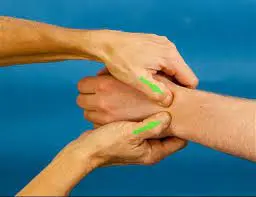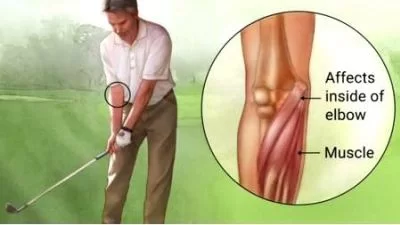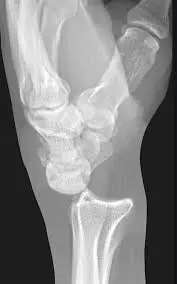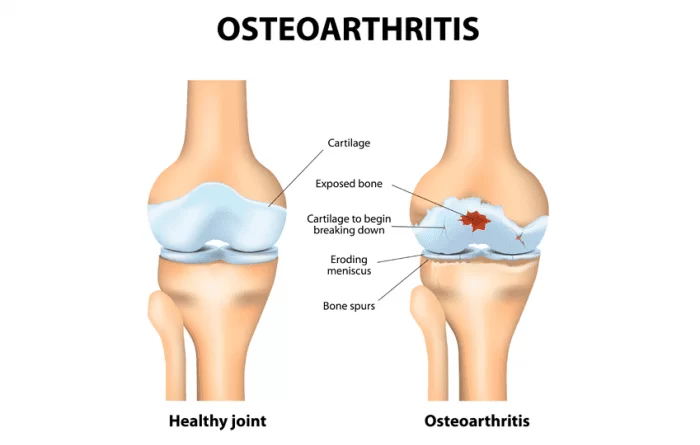Shoulder Blade Pain
Shoulder blade pain, also known as scapular pain, is a common discomfort that affects many individuals of all ages and lifestyles. The shoulder blade, medically referred to as the scapula, is a triangular-shaped bone located on the upper back that connects the upper arm bone (humerus) to the collarbone (clavicle).
Shoulder blade pain can manifest as a dull ache, sharp pain, or a persistent, nagging sensation, often radiating to surrounding areas such as the neck, upper back, and arms. This pain can be caused by a variety of factors, ranging from muscle strains and injuries to more serious underlying medical conditions.
The scapula or shoulder blade is the bone that attaches the clavicle bone to the humerus joint. The scapula bone forms the posterior side of the shoulder girdle. It is a sturdy, flat, triangular bone. The scapula provides attachment to many groups of muscles.
People with shoulder pain usually have aching, dull, aching, or shooting pain in the upper back between the shoulder blades. The area around or under the shoulders is painful. it hurts It may also even worsen while you do positive rehabilitation activities, such as turning your head or reaching for an object. In most cases, shoulder pain is nothing to worry about. But in some cases, it can be a sign of an additional serious condition.
Table of Contents
Cause Of Shoulder Blade Pain
There are some possible conditions for pain between your shoulder blades. Damage to a shoulder muscle or a tendon around the shoulder blades is a common trusted Source reason for this different kind of ache. More serious conditions are also possible.
- Muscle strains
- Muscle strains can affect from
- poor posture
- heavy lifting objects
- working at a computer for a prolonged period of time exercise
- other Conditioning, even during sleep Injuries
- damage to another parts of your body can also lead to ache between your shoulder blades area. These injuries might involve
- rotator cuff tears
- spine fractures
- shoulder dislocation
- other injuries that cause trauma
other cause of shoulder blade pain
- degenerative disc disease, or a herniated or bulging disc disorder in the spine area
- scoliosis
- osteoarthritis disorder in the joints around your neck, spine, or ribs
- spinal stenosis disorder, or a narrowing of your spinal cord
- acid reflux
- fibromyalgia
- shingles
- myofascial pain syndrome
- certain cancers, similar as lung cancer, lymphomas, liver cancer, esophageal cancer, mesothelioma, and cancers that spread to the bony area.
- nerve compression
Emergency causes
Some sudden events that cause shoulder pain require emergency treatment. These can frequently cause severe pain, but not always. similar conditions involve:
- Heart attack. Shoulder blade pain is occasionally a trusted Source of a symptom of heart attack, especially among women. other signs, similar to chest pain and shortness of breath, may also be present. Seek related emergency medical treatment if you experience these symptoms.
- Aortic tear. Thoracic aorta rupture, or aortic dissection, occurs when you have a tear or rupture in the internal layer of the aorta, which is a large blood vessel that branches off from your heart. This can cause trusted Source a sharp, severe ache in your upper middle back area. However, call your local emergency services right away, If this happens. An aortic tear is considered a medical emergency case.
- Pulmonary embolism. People who are experiencing a pulmonary embolism report trusted Source a sudden, sharp pain in their shoulder blades, frequently companies by shortness of breath. This can result from blood clots in their legs breaking off and traveling to their lungs. Get emergency medical support immediately if you suppose you have a pulmonary embolism.
Symptoms Of Shoulder Blade Pain
- The scapula, also referred to as the shoulder blade, is a broad, flat, triangular bone that is located halfway up your back. You have 2 of them, one on each side of your back area.
- Around the scapula bone, and attached to it, is a network of muscles that support and maintain the scapula’s position and movement. These muscles make it possible for you to move your arms in all direction movement.
- When an injury or condition weakens or else damages these muscles, the position of the scapula may change. This change in the position or motion of the scapula is called dyskinesia condition. It is a usual cause of shoulder blade pain.
- There may be more serious causes of shoulder blade pain, similar to heart attack problems, cancer disease, or blood clots. It is meaningful to see a medical professional for a diagnosis, especially if your pain is a sudden or severe type of pain.
Symptoms of shoulder blade pain may include trusted Source
- pain, which may be either a dull ache or sharp pain, around the scapula area
- weakness in the affected arm, especially when attempting overhead motions
- a limited range of motion that makes it difficult to elevate your arm above your shoulder
- as you move your shoulder, you hear a cracking sound
- a visible projection of the scapula is known as “ winging ”
- a tilted body posture on your affected side
Anatomy Of Shoulder Blade
Our shoulder blades (medically termed it is the scapula bone) refer to an integral part of the shoulder joint area. The bulk of the bone is triangular in shape and sits over the back part of our rib cage, but there are 3 protrusions at the top:
- Glenoid Fossa is a shallow cavity that fits with the top of the upper arm bone (humerus), forming the shoulder joint (a ball and socket type of joint)
- The acromion is an oblong projection over the top of the shoulder joint that forms a bridge over the rotator cuff muscles and forms a joint with the collar bone (clavicle bone)
- Coracoid Process is a smooth hook-shaped protrusion at the front of the shoulder area.
There are a total of 18 different muscles that connect and attach to other parts of the shoulder blade, and each scapula can move
Up( scapular elevation)
down( scapular depression)
forwards( scapular protraction)
backward ( scapular retraction) and also the scapula can
twist( upward and downward scapular rotation).
Nerve Problems
Nerve issues and problems tend to have sensations similar to tingling, pins and needles, numbness, and weakness. Symptoms may travel to other areas near and around the shoulders. It may affect one or both shoulders or arms at the same time.
Bursitis
Patients with shoulder bursitis may report a constant, dull aching shoulder blade pain associated with snapping, grinding( crepitus), or grating noises or sensations with forms of arm movements.
Posture
Patients may report experiencing an aching pain between their shoulder blades area, that seems to worsen after being in one position for a long period of time ( similar to working at the computer for some time)
Muscle Problems
Patients experience a type of dull ache that seems to get aggravated and worse with arm movement and improves with rest. This tends to affect only one arm or shoulder both at the same time.
1. Muscle Strain
patients experience dull, aching pain in the shoulder or shoulder blade that seems to be aggravated with arm movements and improves with rest. It is rare for their shoulder area pain to travel down the arm.
- a new exercise regime
- repetitive overhead arm activities like throwing or lifting weights
- carrying something heavy objects like a backpack
- sleeping awkwardly
- The patient reports that it tends to be a dull pang around one or both shoulder blades that gets worse with activity time and improves with rest time, and the area may be tender to touch.
- generally, these pains and symptoms do not travel downwards into the arm.
2. Rotator Cuff Tear
Patients report experiencing pains that are deep, dull, and ache across their shoulders and shoulder blade, as well as hearing/experiencing crepitus ( popping and cracking noises) that get worse with arm movements. Patients may also experience arm weakness may develop. These sorts of conditions may develop suddenly with an injury, or gradually with use/ degeneration.
Our rotator cuff is a group of muscles that work simultaneously to move the shoulder joint. If any one of them is torn or injured, However, generally from prolonged repetitive arm work or an injury, it’s probable to be tender and aching around the shoulder.
This pain may travel down the arm and to the shoulder blade region, but only on one side.
trigger points, which are also called myofascial trigger points, refer to pea size lump in the muscle which is tender to touch, which are generally formed when muscles are sustained in shortened positions due to overuse or poor or awkward position( ergonomics). Patients generally experience dull, deep, aching pain which may travel down the arm or up the neck area.
Trigger points are small, tight bands in the muscle fascia which can be extremely sensitive to any normal touch. They’re generally found and cause pain in the shoulder blade area, generally described as a dull, deep, aching pain that may extend down to the arm.
Diagnosis
To determine the cause of your shoulder blade disorder, your doctor might also run tests on your body’s muscle and resistance capacity.
They may also define imaging tests similarly as
- X-ray
- CT scan
- MRI scan
- Your doctor may refer you to a specialist similar to a neurologist or an orthopedic doctor for further decisions and specialized treatment.
Medical Treatment
- Take over-the-counter pain relievers
- Over-the-counter pain relievers are a quick route to decrease inflammation and pain. Aspirin, ibuprofen, naproxen, and paracetamol are all viable options.
- Diagnosis will trust Source begins with your doctor discussing your medical history and symptoms with you. They will then physically examine your shoulder joint and scapula to define areas of weakness, tenderness, or tightness.
Physiotherapy Treatment
Cross-body stretch

Reaching across the body is an activity that involves the rhomboids muscle and trapezius muscles, and both of these muscles can be the site of shoulder area pain. One therapeutic exercise your therapist might prescribe to stretch the rhomboid muscle, and trapezius muscles and reduce pain between the shoulder blades is the cross-body stretch.
- Stand up straight or sit up straight on the border of a stable chair.
- Slowly muscle stretch your right arm across your chest region until you can grab it with your left hand.
- Hold this cross-body shoulder stretch position for five to ten seconds. You should feel a muscle stretch between your shoulders. To deepen the stretch, you can use your left hand to pull the right arm closer to your chest side.
- Release the muscle stretch and return to the starting position.
- Repeat these steps to stretch the opposite side.
- Go on repeating the steps until you’ve stretched both shoulders muscles.
Rounded-shoulders stretch
Movements that cause a patient to reach your arms in front side of you use the shoulder muscles between your shoulder blades. They can also be used to shoulder muscle stretch the muscles to decrease pain between the shoulder blades. An exercise your physiotherapist might suggest that uses such a movement is the rounded-shoulders pull.
- Stand position or sit position on the edge of a stable chair with good posture.
- Slowly raise both arms in front of you until they are about shoulder height.
- Clasp your hands with your palms facing away from you.
- Let your head drop toward your chest side.
- Reach forward with your arms until your shoulders are rounded and you feel a muscle stretch between them. Concentrate muscle on pulling your shoulder blades away from each other.
- Hold this muscle stretch for five to ten seconds.
- Return to the starting position, and rest for about ten seconds.
- Repeat these above steps until you’ve completed them 3 times.
Cow Face pose
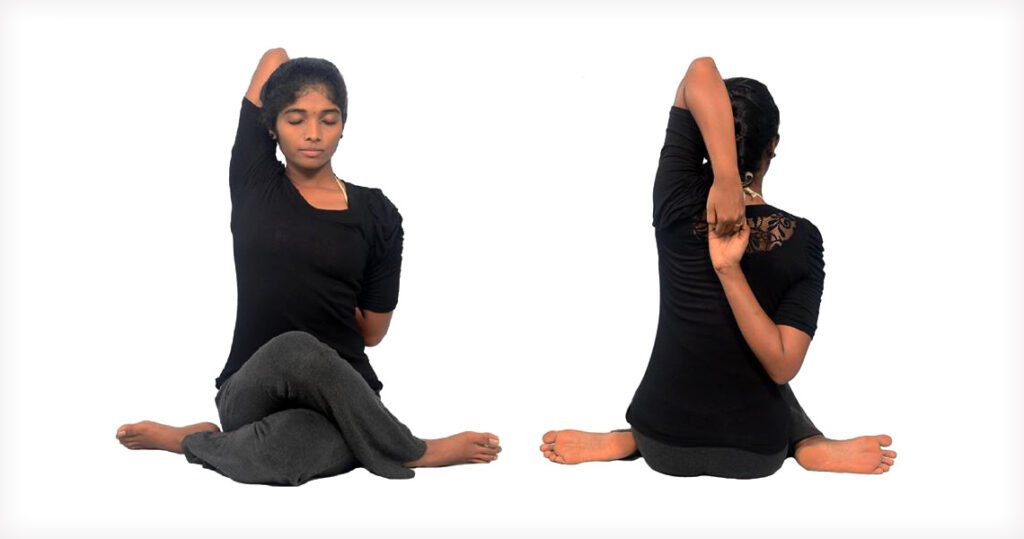
The Cow Face pose stretch is another yoga stretch for the shoulder muscles. To do the Cow Face pose:
- Stand with the feet hip-width apart.
- Reach the right arm up straight toward the roof.
- flex the right side arm at the elbow.
- Keeping the elbow raised position, reach the right hand over the head and down the backside.
- Stretch the left arm down toward the ground.
- Reach the left-hand back side and up the back area.
- If it feels natural and comfortable, bring the left and right hands together and clasp them.
- Take three or four deep breaths.
- Release the stretch of the muscle and repeat it on the other side.
Shoulder blade stretch
After some self-massage techniques on the shoulder muscle area, you can move on to muscles stretching the rhomboid muscles and deltoid muscles area, which will help muscle release tension in that area further.
- Place the right elbow on the left elbow side
- Then you should take your left side hand and interlace it around the right side arm
- In this position, you can apply more pressure to feel your upper back area opening
- Hold the end above position for 20-30 seconds
- Repeat on the other side
Shoulder blade squeeze
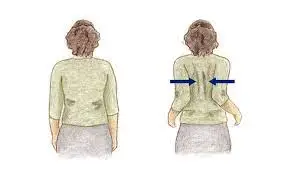
- Sit position or stand position with your arms at your sides.
- Keep your shoulders relaxed, do not shrug.
- Squeeze your shoulders together. Hold for 6 seconds and then relax period.
- Repeat 8-12 times.
Arm circles
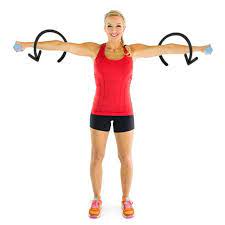
- This is a shoulder stretch that relaxes the muscles and helps you become more flexible.
- Stand tall with your hands, feet shoulder-width apart and arms straight at your sides. Move your arms forward in large circles. Remember to keep your arms straight. After several repetitions, change direction to move your arms back in a circle. Do 15-20 repetitions in both directions.
Plank
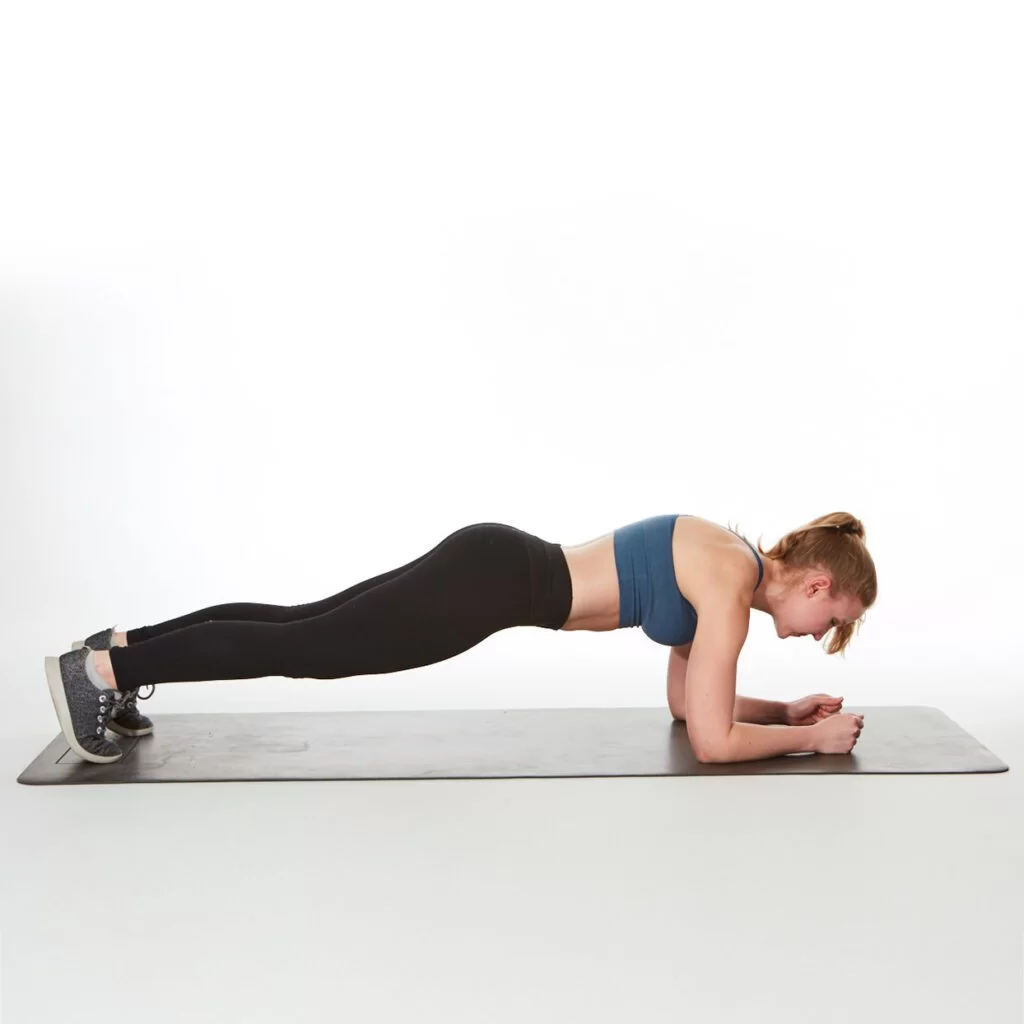
This exercise is designed to strengthen your shoulder muscles, back muscles, and core muscles. The plank is a prevalent exercise recommended for other conditions, and it is sometimes done using the hands.
Try doing it on your elbows instead to help decrease shoulder strain condition.
- Lie on the ground facing down, with your elbows bent.
- Tighten your abdominal muscles as you lift your hips and knees off the ground.
- Hold for 30 seconds, then resume your starting in the same position.
- Rest for 30 seconds, then repeat the plank exercise.
- Gradually work up to five repetitions a day.
Give yourself a massage
- There are easy home remedies(treatments) you can also try. A foam roller technique or massage ball technique is your good and best massage technique. Roll the foam roller massage technique or ball massage technique used under your shoulder blade until you find a tender point area. Once you find the spot area, slowly roll side-to-side, up-and-down, or in a circular pattern. Do this for a minute or more. It should feel like a good, best, and free pain – as if you’re releasing something. Feel good and free to use this massage technique once or even twice a day.
Surgery Treatment
Surgery treatment is only rarely required to resolve shoulder blade pain problems.
According to the doctor, the large majority of people with shoulder blade pain respond to nonsurgical options, such as a change of activities, rest period, exercise, and medications Surgery is usually reserved for cases involving:
- severe shoulder blade pain
- non-responsiveness to more conservative treatment
- severe arthritis
- scapula fracture
- injuries treatable by surgery
- If your doctor does recommend surgery option, it may involve removing scar tissue or repairing tendons in your shoulder or upper back area. Shoulder muscle replacement surgery may also be considered.
Preventing Shoulder Blade Pain
- After you’ve found an efficient way to relieve your shoulder blade pain, the next step is prevention. How can you prevent this shoulder blade pain from happening again? The main route to prevention is exercise. muscle Strengthening exercises and muscle stretching in the weak or previously injured area will help you avoid pain down the road. Make sure you slowly ease into shoulder exercise.
Tips for prevention
- The following measures may help prevent shoulder blade injuries and pain.
- Maintain good posture. Right posture is one of the best preventive measures for shoulder pain. Stand tall, sit erect, and avoid slouching. You might invest in an ergonomic workplace object such as chairs and pillows to assist you.
- Sit only for a short period of time. Stretch frequently and get up for frequent breaks when you are working at a computer or desk area. This will help keep your muscles limber. Standing the desk is a good and best option.
- Be careful when you lift. Lifting heavy items can sometimes cause injuries. When you do lift an item, bend your knees first, and do not strain when lifting objects. Avoid lifting overly heavy objects.
- Warm up first. Always do light and easy stretching as a warmup period of time before a workout or exercise period. This will prime your muscles for activity and help avoid shoulder injury.
- Maintain a healthy lifestyle. Eat a nutritious diet, get sufficient sleep, and exercise regularly for a healthy life. Find the best method to manage stress and keep a positive attitude. These regular practices will help you feel rested and better able to stay physically and mentally fit.
- Exercise regularly, and keep in mind, that the key to long-term relief, is to keep training, which you often will have to do for several months. Strengthening exercises ought to be done two to three times a week, with a one–two days pause. Stretching exercises can be done.
Summary
Shoulder blade pain, also known as scapular pain, is a common issue that affects people of all ages and lifestyles. The shoulder blade, or scapula, is a triangular bone on the upper back that connects the upper arm bone to the collarbone. It plays a crucial role in shoulder joint movement and stability.
Shoulder blade pain can present as a dull ache, sharp pain, or a persistent sensation, often radiating to the neck, upper back, and arms. The causes of this pain vary and can include muscle strains, injuries, and underlying medical conditions.
While this overview provides general information about shoulder blade pain, it is essential to seek professional medical advice for accurate diagnosis and appropriate treatment. Persistent or severe shoulder blade pain should not be ignored, and a healthcare professional can offer personalized guidance to address the issue effectively.
FAQs
A common and common cause of shoulder pain is muscle tension, also known as a pulled muscle. This can be caused by overuse or tension in the arms or upper back. A muscle can also become tight if you’ve been sleeping in a new bed, in a new position, or even if you’ve recently started a new exercise program.
Pain and/or discomfort around the scapula, especially at the top and medial (inside edge), are the most typical signs of shoulder blade pain. The affected arm may feel weak or “dead” when you try to use it forcefully. fatigue brought on by repetitive motions, particularly overhead movements.
A foam roller or massage ball is your best massage technique. Roll the foam roller or ball under your shoulder blade until you find a tender spot area. Once you find the spot area, slowly roll side-to-side, up-and-down, or in a circular pattern. Do this for a minute or more. It should feel like a good and free pain – as if you’re releasing something. Feel good and free to use this massage method once or even twice a day.
Ice packs: Applying a cold pack will assist reduce swelling and numb the area, which will relieve shoulder discomfort if it is caused by an injury.
Heat treatment.
Stretching.
Avoid heavy lifting.
Improve your posture.
Pain Killer Medicine
a limited range of motion that makes it difficult to elevate your arm above your shoulder
a snapping sound when you move your shoulder
a visible projection of the scapula is known as “ winging ”
a tilted posture on your affected side

